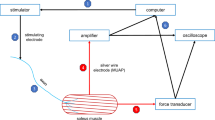Abstract
-
1.
In anaesthetized cats the effects of temperature on the nervous outflow from skeletal muscle via thick myelinated afferent fibres were studied. Single unit recordings were made from afferents of muscle spindles and tendon organs during slow and fast temperature changes of the medial gastrocnemius muscle which was deefferented by ventral root section and prestretched to a tension of 100 p.
-
2.
Group I afferent units from muscle spindles were activated by warming and depressed by cooling, the effect of warming being much more pronounced than that of cooling. Afferents from secondary spindle endings with a high background discharge behaved similar to Ia fibres, whereas those with a low initial discharge rate showed an activation by cooling and a depression (mostly to cessation of firing) by warming. The discharges of group I afferents from tendon organs varied; an activation by warming was the most frequently observed reaction.
-
3.
Some of the afferents from muscle spindles and tendon organs showed signs of a dynamic sensitivity to thermal stimulation, but in general the dynamic component in the responses to temperature changes was only small.
-
4.
The results suggest that the afferent outflow via thick myelinated fibres from a resting, moderately prestretched muscle strongly depends on temperature. At raised intramuscular temperatures (about 42°C) the nervous outflow is characterized by an increased activity in all of the I a and many of the I b afferents, while the majority of group II spindle afferents will be depressed. In contrast, in a cold muscle (about 29°C) the nervous outflow via afferents from primary spindle endings will be reduced, while the net activity from secondary spindle endings will be increased and no marked changes are expected to occur in the discharges of I b fibres.
Similar content being viewed by others
References
Asmussen, E., Bøje, O.: Body temperature and capacity for work. Acta Physiol. Scand.10, 1–22 (1945)
Asmussen, E., Johansen, S. H., Jørgensen, M., Nielsen, M.: On the nervous factors controlling respiration and circulation during exercise. Acta Physiol. Scand.63, 343–350 (1965)
Bernhard, C. G., Granit, R.: Nerve as model temperature end organ. J. Gen. Physiol.29, 257–265 (1945)
Buchthal, F., Høncke, P., Lindhard, J.: Temperature measurements in human muscles in situ at rest and during muscular work. Aeta Physiol. Scand.8, 230–258 (1944)
Edwards, R. H. T., Hill, D. K., McDonnell, M.: Myothermal and intramuscular pressure measurements during isometric contractions of the human quadriceps muscle. J. Physiol. (Lond.)224, 58–59P (1972)
Eldred, E., Lindsley, D. F., Buchwald, J. S.: The effect of cooling on mammalian muscle spindles. Exp. Neurol.2, 144–157 (1960)
Franz, M., Mense, S.: Muscle receptors with group IV afferent fibres responding to application of bradykinin. Brain Res.92, 369–383 (1975)
Hensel, H.: Cutaneous thermoreceptors. In: Handbook of Sensory Physiology. Vol. II, Somatosensory System (A. Iggo, ed.), pp. 79–110. Berlin-Heidelberg-New York: Springer 1973
Hertel, H.-C., Howaldt, B., Mense, S.: Responses of group IV and group III muscle afferents to thermal stimuli. Brain Res.113, 201–205 (1976)
Hunt, C. C., Kuffler, S.: Stretch receptor discharges during muscle contraction. J. Physiol. (Lond.)113, 298–315 (1951)
Job, C.: Über autogene Inhibition und Reflexumkehr bei spinalisierten und decerebrierten Katzen. Pflügers Arch.256, 406–418 (1953)
Leitner, L.-M., Dejours, P.: Reflex increase in ventilation induced by vibrations applied to the triceps surae muscles in the cat. Resp. Physiol.12, 199–204 (1971)
Lippold, O. C. J., Nicholls, J. G., Redfearn, J. W. T.: A study of the afferent discharge produced by cooling a mammalian muscle spindle. J. Physiol. (Lond.)153, 218–231 (1960)
Matthews, P. B. C.: Mammalian muscle receptors and their central actions, pp. 101–194. London: Arnold 1972
McIntyre, A. K.: Central actions of impulses in muscle afferent fibres. In: Handbook of Sensory Physiology, Vol. III/2: Muscle Receptors (C. C. Hunt, ed.), pp. 235–288. Berlin-Heidelberg-New York: Springer 1974
Michalski, W. J., Séguin, J. J.: The effects of muscle cooling and stretch on muscle secondary endings in the cat. J. Physiol. (Lond.)253, 341–356 (1975)
Author information
Authors and Affiliations
Rights and permissions
About this article
Cite this article
Mense, S. Effects of temperature on the discharges of muscle spindles and tendon organs. Pflugers Arch. 374, 159–166 (1978). https://doi.org/10.1007/BF00581297
Received:
Issue Date:
DOI: https://doi.org/10.1007/BF00581297




